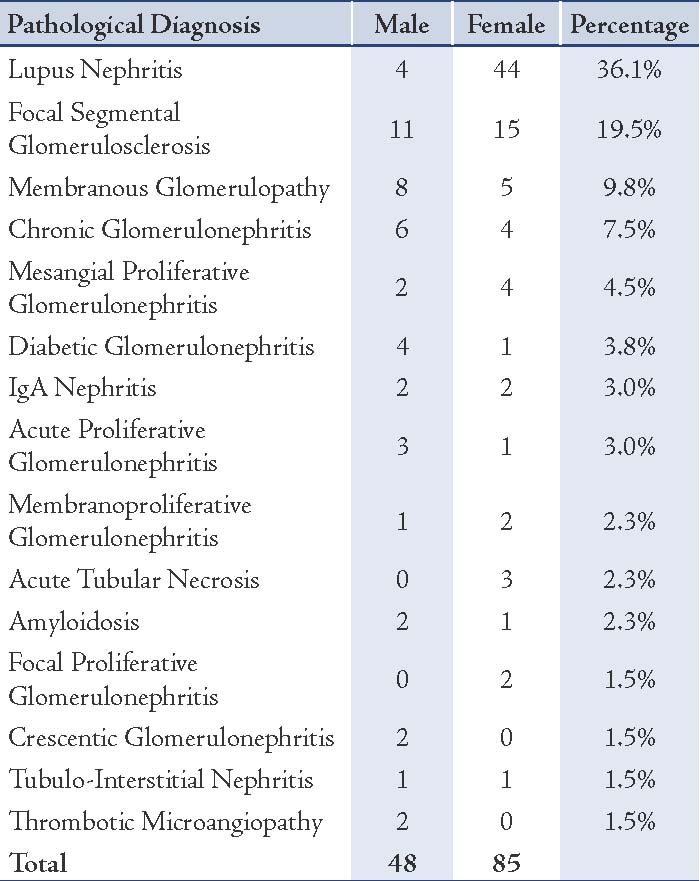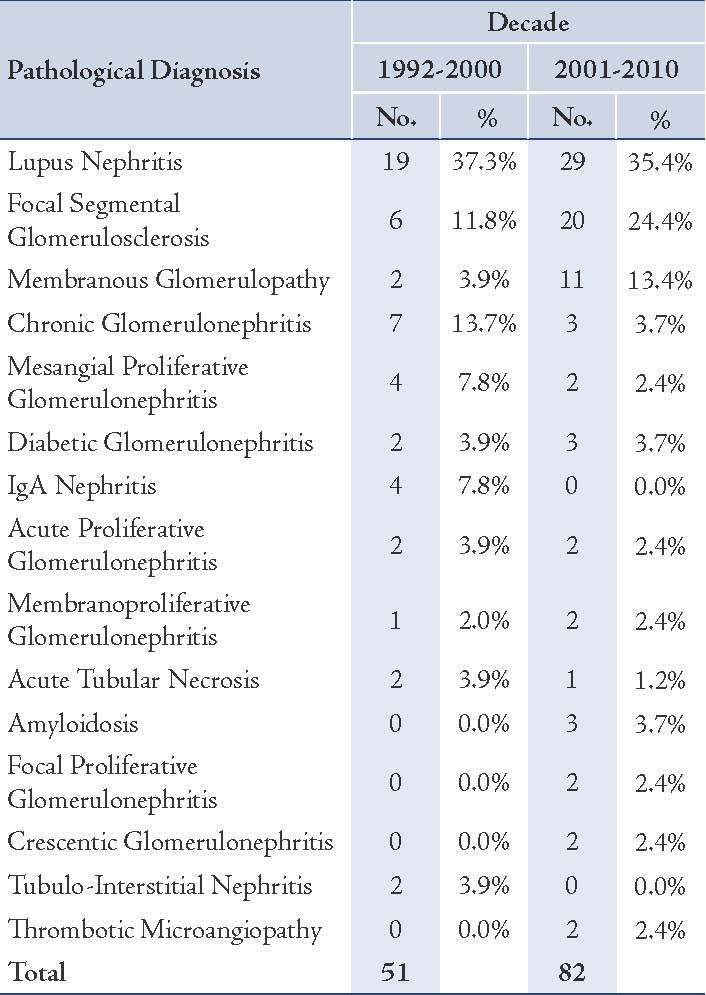| |
Abstract
Objective: To study the pattern of glomerular disease (GD) from the result of renal biopsies at our center.
Methods: We conducted a retrospective review of 190 adult native renal biopsy reports from the pathology registry of renal biopsy performed at our hospital between 1992 and 2010.
Results: Lupus nephritis was the most common pathology 48/133 (36.1%) with a female preponderance. The most common primary glomerular disease was focal segmental glomerulosclerosis (FSGS) 26/133(19.5%), followed by membranous glemerulopathy (MGN) 13/133 (9.8%), and mesangial proliferative glomerulonephritis 6/133 (4.5%). IgA nephropathy and acute proliferative glomerulonephritis each accounted for 4/133 (3.0%). Membranoproliferative glomerulonephritis accounted for 3/133 (2.3%). Focal proliferative and cresentic glomerulonephritis each accounted for 2/133 (1.5%). Vasculitis was not common and there was no report of anti-GBM disease.
Conclusion: Among the secondary glomerular diseases, lupus nephritis was the commonest condition with a female preponderance. Among the primary glomerular diseases, FSGS was the commonest. These results are consistent with global trend. IgA nephropathy is not common as the case in the Caucasian population. Vasculitis was not common and there was no report of anti-GBM disease.
Keywords: Renal biopsy; Glomerular disease; Epidemiology.
Introduction
The incidence of glomerular disease has changing patterns depending on age, ethnicity, and geographic regions and also influenced by environmental, nutritional and socioeconomic factors. It is important to recognize the glomerular disease pattern and incidence in any given geographical area to understand the etiology as well as factors leading to progression of the disorder to end-stage renal disease (ESRD). To establish data on the spectrum of glomerular disease in the Sultanate of Oman, we reviewed the reports of renal biopsies performed between 1992 and 2010 at Sultan Qaboos University Hospital, which is one of only two tertiary care centers dealing with renal biopsies in Oman.
Methods
A retrospective review of the adult (>18 years) native renal biopsy reports from the pathology registry of renal biopsy performed at our hospital between 1992 and 2010 was conducted. We analyzed the data from Sultan Qaboos University Hospital which is one of the two tertiary care centers dealing with renal biopsies in Oman. All the biopsies were performed under ultrasound guidance. Renal reports from nephrectomy and mass biopsy were excluded. Thirteen reports of normal renal tissue were excluded in the analysis. The reports were from a single experienced nephropathologist. The interpretation of the renal pathology was based on examination by light microscopy, immunofluorescence (IF), and electron microscopy (EM). However, 11/133 (8.2%) biopsies were not examined by EM.
Results
There were 133 biopsy reports after exclusion of the biopsies from pediatric patients, renal grafts, renal masses and nephrectomies. There were 85/133 (63.9%) female patients and 48/133 (36.1%) male patients of ages ranging from 18 to 90 year. There was a variety of indications for the reviewed biopsies which included proteinuria, hematuria, and unexplained renal impairment. The spectrum of the pathological diagnosis is presented in Table 1. Lupus glomerulonephritis was the most common pathology 48/133 (36.1%) with a female preponderance. The most common primary glomerular disease was FSGS 30/190 (15.8%) followed by MGN 13/133 (9.8%) and mesangial proliferative glemerulonephritis 6/133 (4.5%). IgA nephropathy and acute proliferative glomerulonephritis each accounted for 4/133 (3.0%). Membranoproliferative glomerulonephritis accounted for 3/133 (2.3%). Focal proliferative and cresentic glomerulonephritis each accounted for 2/133 (1.5%). Among the secondary glomerular diseases, after lupus nephritis, diabetes nephropathy was reported in 5/133 (3.8%). Tubulointerstitial nephritis (TIN) and thrombotic microangiopathy each accounted for 2/133 (1.5%) of all renal biopsies. Amyloidosis was reported in 3/133 (2.3%). There was no report of anti-GBM disease. We did not find a change in the pattern of the glomerular diseases over the span of the study period when compared by decade, 1992-2000 and 2001-2010. (Table 2)
Table 1: Spectrum of pathological diagnosis.

Table 2: Spectrum of pathological diagnosis by decades.

Discussion
Lupus glomerulonephritis was the most common pathology with a female preponderance, a finding consistent with reports from Arab as well as other regions.1-5 We showed, in contrast to other studies, that GD is more common in females.1-3,6,7This can be explained by the domination of the number of reports with lupus nephritis. This study showed that FSGS followed by MGN were the commonest primary GD. This is similar to the reports from USA and other North American countries.8-10 This is also consistent with the reports from the Arabian Gulf countries. In the Kingdom of Bahrain, Al Arrayed et al.1 reported MCD as being the commonest primary GD followed by FSGS; however, in their analysis, they have included pediatric patients. If pediatric patients were excluded FSGS would likely be the most common disease. In Saudi Arabia, FSGS was the most common primary GN in reports from the central and eastern regions.3,11-13 However, reports from the Western region of Saudi Arabia demonstrated that MGN is the most common primary GN in adults.14 Similar results with high MGN frequency are demonstrated in a study from Iran.15 The high frequency of FSGS and MGN reported in this study is also demonstrated in a large series of 1,793 adult patients from a single center in Pakistan.16
IgA nephropathy was reported in only four patients in this study. Three of them were Indian in origin. Similarly, reports from neighboring countries such as United Arab Emirates,4 Saudi Arabia,3 Bahrain,1 and Iran,15 demonstrated lower rates among the primary GD in contrast to the reported rates from Europe,17 where IgA is the leading cause of GD, USA,9 Brazil,18and the Far East.19,20 There were six reports of mesangial proliferative glomerulonephritis. This histological finding is usually due to IgA nephropathy or lupus nephritis. All the six were examined by IF with no IgA stain. There was no pathological evidence to suggest lupus nephritis like subendothelial deposit or a full-house picture on IF, and when EM was done, there were no reticulo-inclusion bodies. As this was a review on biopsy report, further clinical and serological correlation was only done using the information provided in the biopsy request.
There were more reports of lupus nephritis, FSGS, and MGN in the second decade of the study period. This is because there were fewer renal biopsies done between 1992-2000 due to unavailability of nephrology service for several years, rather than a true increase in the incidence of the diseases. We could not assess the rates of the GD in Oman because we only analyzed the data from Sultan Qaboos University Hospital which is one of the two tertiary care centers dealing with renal biopsies in Oman.
Conclusion
The spectrum of glomerular diseases in this study is consistent with the global trend except for IgA nephropathy, vasculitis, and anti-GBM disease. However, being a single-center study, our findings do not reveal the spectrum of diseases in Oman. It is necessary to establish a single national renal biopsy registry in Oman so that data can be compared.
References
1. Al Arrayed A, George SM, Malik AK, Al Arrayed S, Rajagopalan S, Al Arrayed A, et al. The spectrum of glomerular diseases in the kingdom of bahrain: an epidemiological study based on renal biopsy interpretation. Transplant Proc 2004 Jul-Aug;36(6):1792-1795.
2. Mitwalli AH, Al Wakeel JS, Al Mohaya SS, Malik HG, Abu-Aisha H, Hassan OS, et al. Pattern of glomerular disease in Saudi Arabia. Am J Kidney Dis 1996 Jun;27(6):797-802.
3. Abdou N, Boucar D, El Hadj Fary KA, Mouhamadou M, Abdoulaye L, Mamadou Mourtala KA, et al. Histopathological profiles of nephropathies in senegal. Saudi J Kidney Dis Transpl 2003 Apr-Jun;14(2):212-214.
4. Polenakovic MH, Grcevska L, Dzikova S. The incidence of biopsy-proven primary glomerulonephritis in the Republic of Macedonia-long-term follow-up. Nephrol Dial Transplant 2003 Jul;18(5)(Suppl 5):v26-v27.
5. Heaf J, Løkkegaard H, Larsen S. The epidemiology and prognosis of glomerulonephritis in Denmark 1985-1997. Nephrol Dial Transplant 1999 Aug;14(8):1889-1897.
6. Briganti EM, Dowling J, Finlay M, Hill PA, Jones CL, Kincaid-Smith PS, et al. The incidence of biopsy-proven glomerulonephritis in Australia. Nephrol Dial Transplant 2001 Jul;16(7):1364-1367.
7. Yahya TM, Pingle A, Boobes Y, Pingle S. Analysis of 490 kidney biopsies: data from the United Arab Emirates Renal Diseases Registry. J Nephrol 1998 May-Jun;11(3):148-150.
8. Haas M, Meehan SM, Karrison TG, Spargo BH. Changing etiologies of unexplained adult nephrotic syndrome: a comparison of renal biopsy findings from 1976-1979 and 1995-1997. Am J Kidney Dis 1997 Nov;30(5):621-631.
9. Dragovic D, Rosenstock JL, Wahl SJ, Panagopoulos G, DeVita MV, Michelis MF. Increasing incidence of focal segmental glomerulosclerosis and an examination of demographic patterns. Clin Nephrol 2005 Jan;63(1):1-7.
10. Mazzuchi N, Acosta N, Caorsi H, Schwedt E, Di Martino LA, Mautone M, et al; Programa de Prevención y Tratamiento de las Glomerulopatías. [Frequency of diagnosis and clinic presentation of glomerulopathies in Uruguay]. Nefrologia 2005;25(2):113-120.
11. Al Wakeel JS, Mitwalli AH, Tarif N, Alam AA, Hammad D, Abu-Aisha H, et al. Spectrum and outcome of primary glomerulonephritis. Saudi J Kidney Dis Transpl 2004 Oct-Dec;15(4):440-446.
12. Mousa DH, Al-Hawas FA, Al-Sulaiman MH, Al-Khader AA. A prospective study of renal biopsies performed over one-year at the Riyadh armed forces hospital. Saudi J Kidney Dis Transpl 2000 Jul-Sep;11(3):449-454.
13. Alkhunaizi AM. Pattern of renal pathology among renal biopsy specimens in Eastern Saudi Arabia. Saudi Med J 2007 Nov;28(11):1676-1681.
14. Jalalah SM. Patterns of primary glomerular diseases among adults in the western region of Saudi Arabia. Saudi J Kidney Dis Transpl 2009 Mar;20(2):295-299.
15. Ossareh S, Asgari M, Abdi E, Nejad-Gashti H, Ataipour Y, Aris S, et al. Renal biopsy findings in Iran: case series report from a referral kidney center. Int Urol Nephrol 2010 Dec;42(4):1031-1040.
16. Mubarak M, Kazi JI, Naqvi R, Ahmed E, Akhter F, Naqvi SA, et al. Pattern of renal diseases observed in native renal biopsies in adults in a single centre in Pakistan. Nephrology (Carlton) 2011 Jan;16(1):87-92.
17. Simon P, Ramee MP, Boulahrouz R, Stanescu C, Charasse C, Ang KS, et al. Epidemiologic data of primary glomerular diseases in western France. Kidney Int 2004 Sep;66(3):905-908.
18. Bahiense-Oliveira M, Saldanha LB, Mota EL, Penna DO, Barros RT, Romão-Junior JE. Primary glomerular diseases in Brazil (1979-1999): is the frequency of focal and segmental glomerulosclerosis increasing? Clin Nephrol 2004 Feb;61(2):90-97.
19. Kanjanabuch T, Kittikovit W, Lewsuwan S, Leelahavanichkul A, Avihingsanon Y, Praditpornsilpa K, et al. Etiologies of glomerular diseases in Thailand: a renal biopsy study of 506 cases. J Med Assoc Thai 2005 Sep;88(Suppl 4):S305-S311.
20. Chen H, Tang Z, Zeng C, Hu W, Wang Q, Yu Y, et al. Pathological demography of native patients in a nephrology center in China. Chin Med J (Engl) 2003 Sep;116(9):1377-1381.
|
|